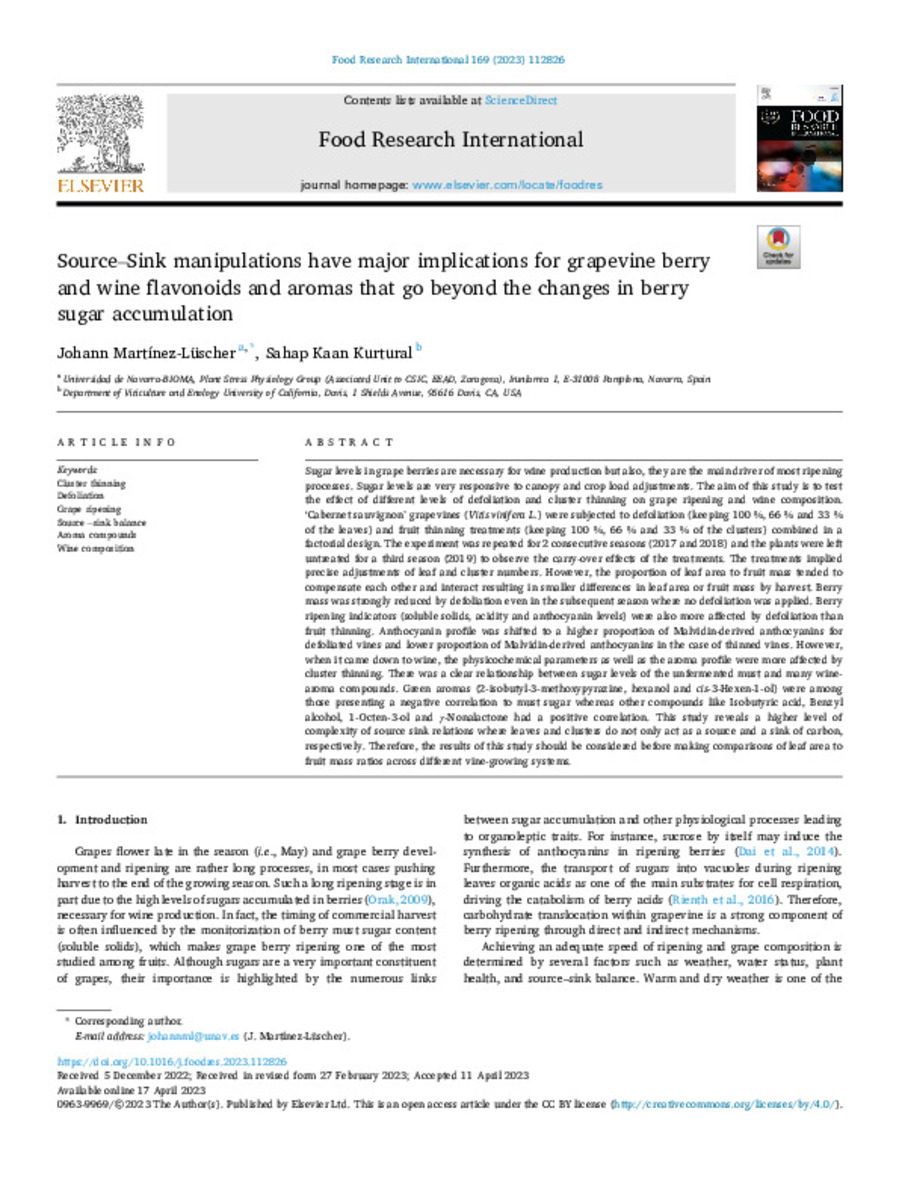Full metadata record
| DC Field | Value | Language |
|---|---|---|
| dc.creator | Martinez-Lüscher, J.D. (Johann David) | - |
| dc.creator | Kaan-Kurtural, S. (Sahap) | - |
| dc.date.accessioned | 2023-11-21T12:36:36Z | - |
| dc.date.available | 2023-11-21T12:36:36Z | - |
| dc.date.issued | 2023 | - |
| dc.identifier.citation | Martinez-Lüscher, J.D. (Johann David); Kaan-Kurtural, S. (Sahap). "Source–Sink manipulations have major implications for grapevine berry and wine flavonoids and aromas that go beyond the changes in berry sugar accumulation". Food Research International. 169, 2023, 112826 | es |
| dc.identifier.issn | 1873-7145 | - |
| dc.identifier.uri | https://hdl.handle.net/10171/67921 | - |
| dc.description.abstract | Sugar levels in grape berries are necessary for wine production but also, they are the main driver of most ripening processes. Sugar levels are very responsive to canopy and crop load adjustments. The aim of this study is to test the effect of different levels of defoliation and cluster thinning on grape ripening and wine composition. ‘Cabernet sauvignon’ grapevines (Vitis vinifera L.) were subjected to defoliation (keeping 100 %, 66 % and 33 % of the leaves) and fruit thinning treatments (keeping 100 %, 66 % and 33 % of the clusters) combined in a factorial design. The experiment was repeated for 2 consecutive seasons (2017 and 2018) and the plants were left untreated for a third season (2019) to observe the carry-over effects of the treatments. The treatments implied precise adjustments of leaf and cluster numbers. However, the proportion of leaf area to fruit mass tended to compensate each other and interact resulting in smaller differences in leaf area or fruit mass by harvest. Berry mass was strongly reduced by defoliation even in the subsequent season where no defoliation was applied. Berry ripening indicators (soluble solids, acidity and anthocyanin levels) were also more affected by defoliation than fruit thinning. Anthocyanin profile was shifted to a higher proportion of Malvidin-derived anthocyanins for defoliated vines and lower proportion of Malvidin-derived anthocyanins in the case of thinned vines. However, when it came down to wine, the physicochemical parameters as well as the aroma profile were more affected by cluster thinning. There was a clear relationship between sugar levels of the unfermented must and many winearoma compounds. Green aromas (2-isobutyl-3-methoxypyrazine, hexanol and cis-3-Hexen-1-ol) were among those presenting a negative correlation to must sugar whereas other compounds like Isobutyric acid, Benzyl alcohol, 1-Octen-3-ol and γ-Nonalactone had a positive correlation. This study reveals a higher level of complexity of source sink relations where leaves and clusters do not only act as a source and a sink of carbon, respectively. Therefore, the results of this study should be considered before making comparisons of leaf area to fruit mass ratios across different vine-growing systems. | es_ES |
| dc.description.sponsorship | American Vineyard Foundation funded this study (AVF Proj.ID:2185) | es_ES |
| dc.language.iso | eng | es_ES |
| dc.publisher | Elsevier | es_ES |
| dc.rights | info:eu-repo/semantics/openAccess | es_ES |
| dc.subject | Cluster thinning | es_ES |
| dc.subject | Defoliation | es_ES |
| dc.subject | Grape ripening | es_ES |
| dc.subject | Source− sink balance | es_ES |
| dc.subject | Aroma compounds | es_ES |
| dc.subject | Wine composition | es_ES |
| dc.title | Source–Sink manipulations have major implications for grapevine berry and wine flavonoids and aromas that go beyond the changes in berry sugar accumulation | es_ES |
| dc.type | info:eu-repo/semantics/article | es_ES |
| dc.description.note | This is an open access article under the CC BY license | es_ES |
| dc.identifier.doi | 10.1016/j.foodres.2023.112826 | - |
| dadun.citation.publicationName | Food Research International | es_ES |
| dadun.citation.startingPage | 112826 | es_ES |
| dadun.citation.volume | 169 | es_ES |
| dc.identifier.pmid | 37254402 | - |
Files in This Item:
Statistics and impact
Items in Dadun are protected by copyright, with all rights reserved, unless otherwise indicated.






